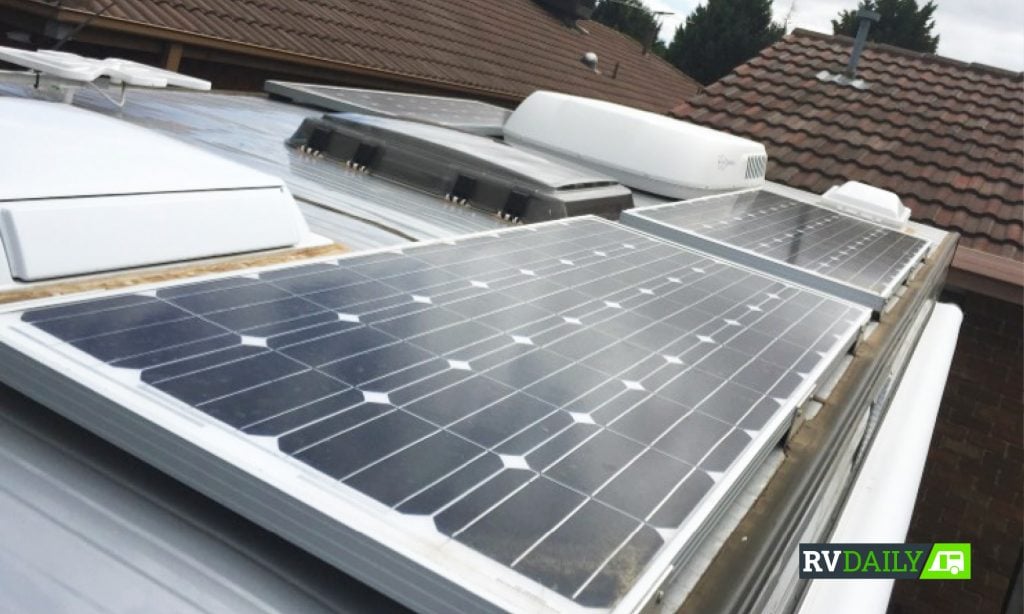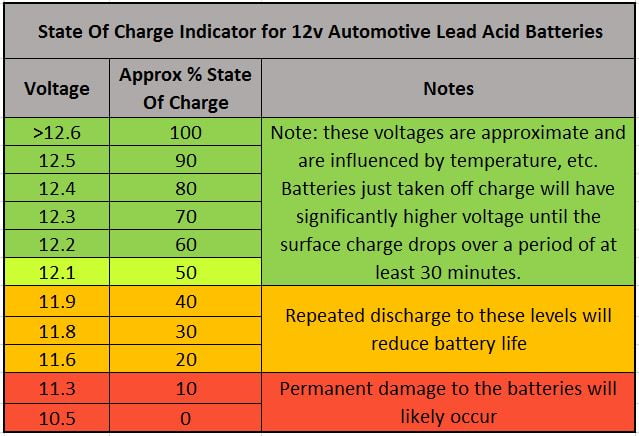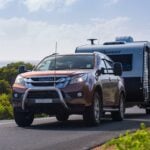
Solar panels for caravans are a tricky subject to get right. Marty reckons he’s had a eureka moment about solar power and you could be doing it wrong.
Hands up if you’ve had difficulty with your RV batteries keeping up with your power demands? Even despite having a good caravan solar panel set-up. I feel your pain. Over the years I’ve had several different 12V installations that included solar charging. Subsequently, they have all let me down in one way or another. What was I doing wrong?
As we travel around this country, talking to other caravanners, they all share similar experiences. For whatever reason, their solar charging systems just can’t keep up with the drain on their batteries. After considering this issue and experimenting a little, I reckon I’ve figured it out. We’ve all been making a huge mistake with our caravan solar installations.

Firstly, let’s understand that solar power generation is not all that efficient. At best, modern solar panels will convert about 20 per cent of the energy falling on them into electrical power. To achieve even that low level of efficiency, the panels need to operate in perfect conditions with sunlight falling directly on them from an angle of 90°.
Are your solar panels mounted on the caravan roof? Well…
Most new caravans, motorhomes, and, to some extent, campers have solar panels mounted on the roof or other flat surfaces. This is a very convenient way to transport and use solar panels. However, it doesn’t help them to face directly into the sun at all times. In Australia, depending on the time of year, the sun will be at a less-than-ideal angle to the surface of our solar panels, and we would be lucky to achieve 14 per cent efficiency.
So, you might wonder, how does this translate into a real-world experience? Our particular caravan has 450 watts of solar panels mounted on the roof. In perfect conditions, it can theoretically output up to 30 amps. They never do, and here’s why.
A little while ago, we upgraded our solar charger to a Redarc BMS 1230S Battery Manager. Now, this unit is no longer available, but you can get the newer model, The Redarc Manager30 S3. This clever Australian-designed and built device can tell you a lot about what’s happening with your 12V system. This includes how many watts your solar panels are actually producing.
In winter, in the southern states, even in full sunlight, the 450W solar panels on our caravan were lucky to produce 230 watts. That’s around half of what they are rated at, and it translates into just 15 amps of charge.

What happens when we use power at the same time as charging?
Now consider we are using power at the same time as charging our caravan solar panels. Accessories like the fridge, TV, DVD player and phone chargers all take power from the battery even when it’s being charged. As a result, we could be putting less than ten amps of charge back into our batteries per hour. Introduce some cloud cover or shadows falling onto the panels, and we can get down as low as just five amps.
Five amps is not a lot when charging 200Ah of AGM batteries. In winter, we might get six hours of daylight, but only four of those hours, between 11 am and 2 am, would the sun be at an angle that is close to being ideal for producing useful power. Conservatively, we might get a total of 20 amp hours of charge over the entire day.
The final nail in the coffin is that we rarely park our caravan in open sunlight, which is not ideal for roof-mounted solar panels. Usually, we camp under trees or in a valley. Even a slight shadow cast by an air conditioner over part of the solar panel can cut output in half.
The reality is that with all these variables taken into consideration, we would really be getting only 10-15 amp hours of net charge per day, and this is simply not enough. Take out the power we use during the night, and it’s little wonder our batteries would barely last a whole weekend without some form of additional charging.
All is not lost …
Fortunately, all is not lost. There is one very simple thing you can do that will dramatically increase your ability to recharge your batteries.

When our van was built, we asked the manufacturer to include a separate Anderson plug that was wired into the existing solar panels. This allows us to plug in external solar panels for our caravan. These, of course, can be placed in direct sunlight to augment the roof-mounted panels. Using the Redarc BMS to monitor our solar watts, we plugged in an external 100W panel in the full winter sunlight. Immediately, our available solar panels jumped by an additional 80 watts!
Now, that’s about as good as it gets with modern solar panels for caravans. By continuously repositioning this panel to be in as near direct sunlight as possible over the available sunlight hours, we were able to add around 20 amp hours to our total charge for the day.
A similar effect can be achieved by plugging an external solar panel into the Anderson plug of your trailer that takes charge from the tow vehicle’s alternator. Just make sure the panel has an inbuilt regulator if the connection goes directly to your battery. If you have a DC-DC charger or similar, then an unregulated panel will suffice.
I’ll admit that repositioning the panel all day is a bit of a chore and not always possible. Nevertheless, it goes to show that adding solar panels external to your caravan roof-mounted panels can lead to a dramatic improvement in your ability to recharge your batteries every day.

The key to understanding your 12V electrical system
The key to understanding your 12V electrical system is to know one very simple equation:
Watts = Volts x Amps or Amps = Watts / Volts.
This is how we know how many amps of charge we can expect from any caravan solar panels. A 100W solar panel divided by 12 volts equates to 8.3 amps. However, an unregulated 12V solar panel can output up to 22 volts in full sun. This is why we need a regulator or solar charger to reduce these high voltages to a level that our 12V batteries can accept. This will result in higher charging amps. Unfortunately, 12V DC is prone to voltage drops and other inefficiencies in the system and trying to work out the variances in the resultant output is extremely difficult. To keep it simple, it’s better to use 15 volts as a baseline when determining recharge time from solar.
It’s important to understand that electrical charging and discharging happens over time. This is why batteries are rated in amp hours. It gives us the ability to estimate how long a battery will last. If we apply a constant load of one amp to a typical 100Ah battery, that battery will be fully discharged in 100 hours. However, most 12V RV batteries don’t like to be discharged below 50 per cent of their state of charge (SOC). With that in mind, our 100Ah battery with a constant load of one amp can be run for 50 hours before we start to damage the battery.

The exception is lithium batteries, which have the ability to discharge to very low levels without sustaining long-term damage.
See, I told you getting solar panels right for caravans was tricky
Back to our example, if we discharge our 100 Ah battery to 50 per cent SOC, it will require 50 amp hours to recharge completely. A 100W panel producing 6.6 amps per hour will theoretically recharge this battery in approximately eight hours. However, this is only if the original load has been turned off and the panel is in near-perfect condition. In reality, it will take around 60 per cent longer due to the inefficiencies of most batteries and the way most solar controllers have what is called an “absorption final stage” in their recharging profile. This is necessary as a battery’s ability to accept charging current will decrease as it gets closer to reaching full charge.
If the solar panels are mounted on the roof of a caravan and are operating during the winter months in southern Australia, it could easily take three days or more to fully recharge that battery. If a load is connected at the same time, such as a 12V compressor fridge, it will take even longer.
So with your caravan solar, hopefully, you’re not doing it wrong – and now you know how to do it right!










Hi Guys when I first started using portable solar panels, and doing a lot of reserch, it was obvious that you had to gain most efficent use, so I spent a bit of time thinking about it and came up with a very simple device any handyman could make, just take a 25mm flat length of aluminium about 300mm long bend it to form a clip fit over edge of your panel take it down so it is over glass bend up at 90 deg another bend at 90 for a couple of cm then another bend down towards glass fix a 20mm x 100mm aluminium tube tube to this,so its just above the glass, when solar panel is in perfect position tube will form a perfect circle shadow on your panel, works great and cost vertually nothing have given them to others and they love them. regards old times think I have been camping for about 64 to old to remember LOL. Good luck give it a go, still have to move panel but will give 100 % of whats available.